Medieval History
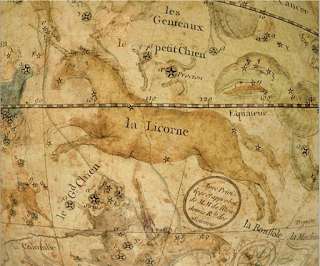 Celestial Globe, detail: Unicorn, Joseph-Jérôme Lalande, 1775. Private Collection, Vienna, Austria
Celestial Globe, detail: Unicorn, Joseph-Jérôme Lalande, 1775. Private Collection, Vienna, Austria
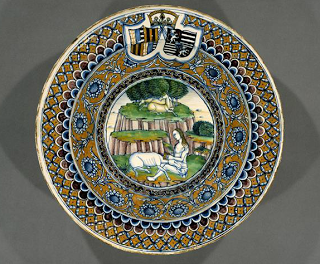 Italian dish, possibly made in Pesaro in 1486-87. Maiolica (tin-enameled earthenware), Metropolitan Museum of Art. The maiden has lured the unicorn to lay submissively on her lap.
Italian dish, possibly made in Pesaro in 1486-87. Maiolica (tin-enameled earthenware), Metropolitan Museum of Art. The maiden has lured the unicorn to lay submissively on her lap.
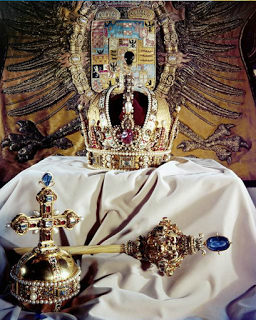 Crown of Rudolf II, later Crown of the Austrian Empire; Imperial Orb and Scepter. Artists: Crown: Hans Vermeyen; orb and scepter: Andreas Osenbruck. Crown: 1602; orb: 1612-17; scepter: 1615. Materials: Crown: gold, partially enamelled, diamonds, spinel rubies, sapphire, pearls, velvet; Orb: gold, partially enamelled, diamonds, rubies, sapphire, pearls; scepter: "Unicorn's horn" (in fact narwhal horn), gold, partially enamelled, diamonds, rubies, sapphire, pearls. Crown made for Rudolf II, Holy Roman Emperor, King of Hungary and Bohemia, by the Imperial Court Workshops in Prague; orb and scepter made for Emperor Matthias in Prague. Kunsthistorisches Museum Wien (Vienna, Austria)
Crown of Rudolf II, later Crown of the Austrian Empire; Imperial Orb and Scepter. Artists: Crown: Hans Vermeyen; orb and scepter: Andreas Osenbruck. Crown: 1602; orb: 1612-17; scepter: 1615. Materials: Crown: gold, partially enamelled, diamonds, spinel rubies, sapphire, pearls, velvet; Orb: gold, partially enamelled, diamonds, rubies, sapphire, pearls; scepter: "Unicorn's horn" (in fact narwhal horn), gold, partially enamelled, diamonds, rubies, sapphire, pearls. Crown made for Rudolf II, Holy Roman Emperor, King of Hungary and Bohemia, by the Imperial Court Workshops in Prague; orb and scepter made for Emperor Matthias in Prague. Kunsthistorisches Museum Wien (Vienna, Austria)
One of the many mythical properties unicorns possess is the power to heal, and the power to cleanse water of toxins by submersing their horn in the water. Kings used similar iconography in their royal objects, purification and healing, and in a Christian framework this connects to Christ as King. Narwhal horns were often used to represent unicorn horns in these settings.
 Procris and the Unicorn, Bernardino Luini, Milanese, c. 1520-1522, fresco. The National Gallery of Art (Washington, D.C.). This fresco is part of the Fresco Cycle with the Story of Procris and Cephalus, and according to the NGA: "Procris extends one arm gently toward a unicorn, which kneels in deference to her purity. This fabulous animal does not come from ancient mythology but, rather, is a symbol of virginity in the Christian faith.
Procris and the Unicorn, Bernardino Luini, Milanese, c. 1520-1522, fresco. The National Gallery of Art (Washington, D.C.). This fresco is part of the Fresco Cycle with the Story of Procris and Cephalus, and according to the NGA: "Procris extends one arm gently toward a unicorn, which kneels in deference to her purity. This fabulous animal does not come from ancient mythology but, rather, is a symbol of virginity in the Christian faith.
The unicorn functions as a metaphor, suggesting that, through her earthly sorrows, Procris has suffered martyrdom and been resurrected. Thus, in translating Niccolò da Correggio's play into painted images, Bernardino Luini followed two Renaissance practices: an interest in reviving classical style as well as a tendency to give moralizing religious meanings to pagan myths."
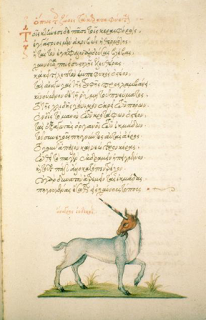
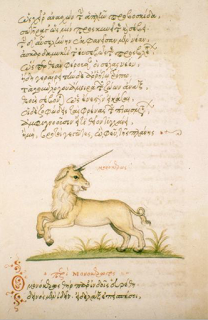 De animalium proprietate, whole page, Folio/Page #: fol. 028r. and Folio/Page #: fol. 029r. Manuel Philes, 1564, French. Text: The Onager. Unicorn-like fantastic animal with grey body, red head and three-coloured horn, as described in the verse. Written by Angelus Vergecius. Bodleian Library, University of Oxford.
De animalium proprietate, whole page, Folio/Page #: fol. 028r. and Folio/Page #: fol. 029r. Manuel Philes, 1564, French. Text: The Onager. Unicorn-like fantastic animal with grey body, red head and three-coloured horn, as described in the verse. Written by Angelus Vergecius. Bodleian Library, University of Oxford.
Some medieval scholars and artists drew on ancient Greek and Roman texts for information on unicorns. These two images show the difference in descriptions found in those texts; one is more horse-like, one more goat-like. Modern scholars believe these ancient writers may have originally described rhinoceros, or a specific species of goat living in the Indian subcontinent.
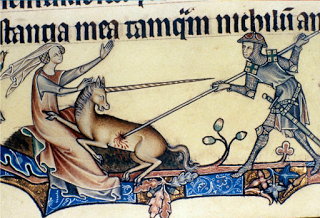 Ormesby Psalter, Folio/Page #: fol. 055v, c. 1300; c. 1310. Made in East-Anglia, English. Bodleian Library, University of Oxford. This is one of the more famous unicorn images in medieval art. In the story of the hunt of the unicorn, a maiden gently lulls the unicorn to rest in her lap, while the hunters surround and slay the unicorn. The imagery always involves a lot of drama, especially here - the maiden's protesting arm, her headdress streaming behind her in sudden movement. Unicorns represent purity and virginity, and it doesn't take much imagination to see this image representing vanquished virginity.
Ormesby Psalter, Folio/Page #: fol. 055v, c. 1300; c. 1310. Made in East-Anglia, English. Bodleian Library, University of Oxford. This is one of the more famous unicorn images in medieval art. In the story of the hunt of the unicorn, a maiden gently lulls the unicorn to rest in her lap, while the hunters surround and slay the unicorn. The imagery always involves a lot of drama, especially here - the maiden's protesting arm, her headdress streaming behind her in sudden movement. Unicorns represent purity and virginity, and it doesn't take much imagination to see this image representing vanquished virginity.
- Medievalists Uncover "lost" Recipe For Roasted Unicorn
As an April Fools' Day prank, the curators of the British Library's Medieval and Earlier Manuscripts Blog wrote up an entirely straight-faced account of a "spine-tingling" discovery ? a cookbook that details the proper way to prepare unicorn....
- Austria's Crown Jewels Offer A Unique Insight Into Medieval Europe
The octagonal crown fashioned from pure gold is studded with 144 precious stones and just as many pearls yet it is a priceless artifact for other reasons . The crown almost certainly once graced the head of the first German emperor Otto I more than 1,000...
- Mermaids
Roman book of hours, whole page, folio 186r. End of fifteenth century, made in Venice or Padua. Historiated initial (D)omine with the Holy Spirit above. Floral border with mermaid and dolphin. Pendant of a mermaid, German. 1580-1590, enameled gold,...
- Rambunctious
What?s up Medievalists? Bestiary time!I have a great prof for my Medieval Europe class this semester: he links us to pictures and interactive websites and asks us to write about them, which is fantastic homework. Anyway, I tell you this because I found...
- Medieval Exhibitions In New York
I am currently on vacation in the New York area, and thus I had a chance to explore the museums of New York City a little bit. As always, there are plenty of medieval things on offer here - the following is my recommendation to lovers of medieval art...
Medieval History
'Monokeros,' or unicorns in imagery and myth



One of the many mythical properties unicorns possess is the power to heal, and the power to cleanse water of toxins by submersing their horn in the water. Kings used similar iconography in their royal objects, purification and healing, and in a Christian framework this connects to Christ as King. Narwhal horns were often used to represent unicorn horns in these settings.

The unicorn functions as a metaphor, suggesting that, through her earthly sorrows, Procris has suffered martyrdom and been resurrected. Thus, in translating Niccolò da Correggio's play into painted images, Bernardino Luini followed two Renaissance practices: an interest in reviving classical style as well as a tendency to give moralizing religious meanings to pagan myths."


Some medieval scholars and artists drew on ancient Greek and Roman texts for information on unicorns. These two images show the difference in descriptions found in those texts; one is more horse-like, one more goat-like. Modern scholars believe these ancient writers may have originally described rhinoceros, or a specific species of goat living in the Indian subcontinent.

- Medievalists Uncover "lost" Recipe For Roasted Unicorn
As an April Fools' Day prank, the curators of the British Library's Medieval and Earlier Manuscripts Blog wrote up an entirely straight-faced account of a "spine-tingling" discovery ? a cookbook that details the proper way to prepare unicorn....
- Austria's Crown Jewels Offer A Unique Insight Into Medieval Europe
The octagonal crown fashioned from pure gold is studded with 144 precious stones and just as many pearls yet it is a priceless artifact for other reasons . The crown almost certainly once graced the head of the first German emperor Otto I more than 1,000...
- Mermaids
Roman book of hours, whole page, folio 186r. End of fifteenth century, made in Venice or Padua. Historiated initial (D)omine with the Holy Spirit above. Floral border with mermaid and dolphin. Pendant of a mermaid, German. 1580-1590, enameled gold,...
- Rambunctious
What?s up Medievalists? Bestiary time!I have a great prof for my Medieval Europe class this semester: he links us to pictures and interactive websites and asks us to write about them, which is fantastic homework. Anyway, I tell you this because I found...
- Medieval Exhibitions In New York
I am currently on vacation in the New York area, and thus I had a chance to explore the museums of New York City a little bit. As always, there are plenty of medieval things on offer here - the following is my recommendation to lovers of medieval art...
